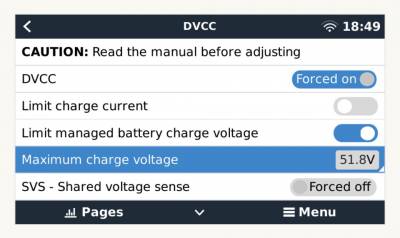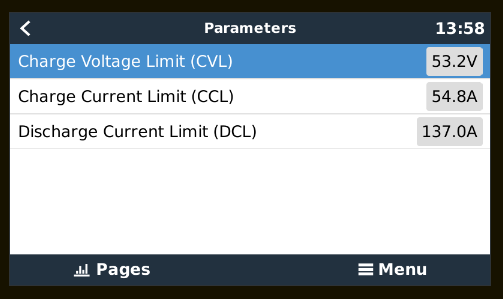Are you making use of the ESS assistant on the Multi?
The best would be to follow the Victron page:
https://www.victronenergy.com/live/battery_compatibility:pylontech_phantom
I would first start there and make sure that the Multi & GX is configured according to the Victron documentation.
They do also mention high voltage:
Note: The “Limit managed battery charge voltage” feature should be left OFF, unless you are experiencing “High Voltage” or “Internal Error” alarms. These alarms can indicate that there is an internal cell imbalance in the battery. It may be useful in this situation to enable this feature, and then adjust the voltage limit down so that the batteries are able to balance charge without reaching over voltage internally. This imbalance is at a cell level, so might not be reflected as a high overall battery voltage if measured with a Multimeter. This can then be turned off once the battery has balanced itself properly.
And a second part under the FAQ (I see they are recommending to keep the batteries charged until the error goes away in order for the BMS to do it’s thing (top balance):
High voltage’ warning or alarm shown on battery status
The ‘high voltage’ warning or alarm is not unusual on new batteries that are not yet balanced. To help the batteries balance quickly, keep the batteries fully charged until the errors go away. In an ESS system, set it to ‘keep batteries charged’, in an off-grid system the fastest way is to either charge / balance the battery before installation, or to fully charge with a generator if not enough solar is available to keep the batteries fully charged.
If you are unable to maintain the target voltage to balance the batteries without the ‘high voltage’ alarm occurring, you may need to enable and set the “Limit managed battery charge voltage” setting in the DVCC menu of the GX device. Reduce this voltage as necessary until the alarm stops. After sufficient time to balance the batteries, try increasing this value until it can be disabled again for normal operation.

If it is not possible to raise the voltage over time, and eventually disable this manual override:
1: If you have 2 or more batteries in your system, you can try shutting down the system once it is as close to fully charged as possible, and then physically connecting the batteries in smaller groups (or even individually) so that balancing can occur on each individual battery without it being masked by the others connected in parallel. It may help you to see the indicator lights on the battery (if available on that model) to find which battery might be out of balance with the others.
2: Contact your Pylontech dealer for further assistance (they can provide additional software to see individual cell level data), or assist with other potential solutions.
So I would say configure it according to the Victron docs. If you still have the alarm then I would say that you can then look in detail at the FAQ about high voltage and then you will most likely have to enable “Limit managed battery charge voltage” and drop the “Maximum charge voltage” until you no longer get the alarm and give the battery some time to balance while having it set to “Keep batteries charged”. After a while you can then increase the value and if you don’t get alarms when you’re back at 52.4V you can disable the option again.
Edit:
Should have just posted the link first which has a nice table including DVCC:
| Venus Settings → System Setup Parameter |
Value |
| DVCC |
ON |
| Shared Voltage Sense |
OFF |
| Shared Temperature Sense |
OFF |
But still, have a look at the documentation and configure it like that and you should be good to go.





